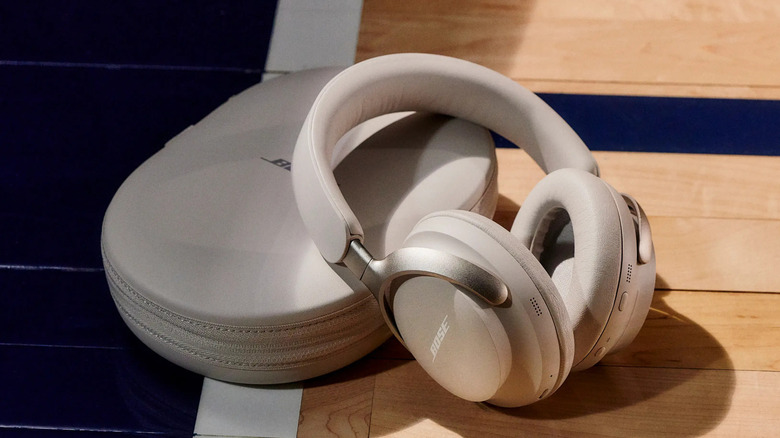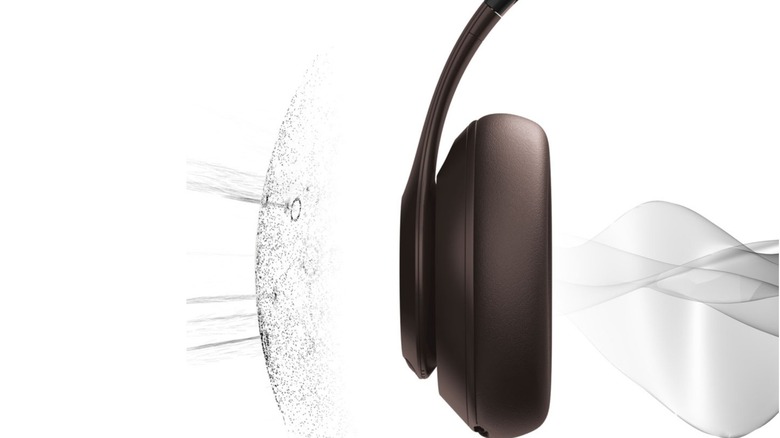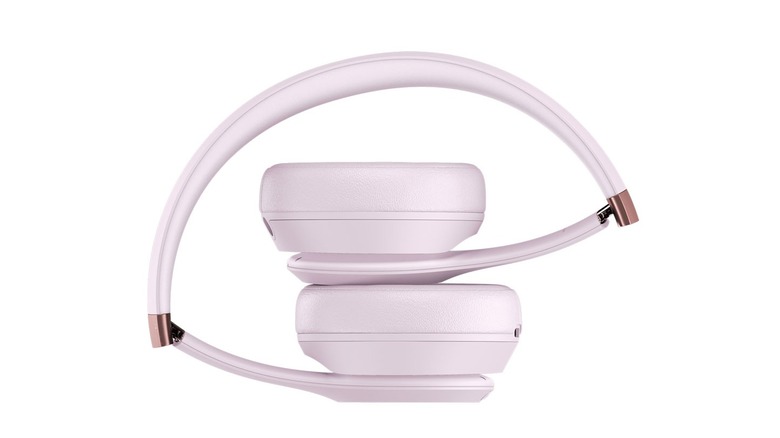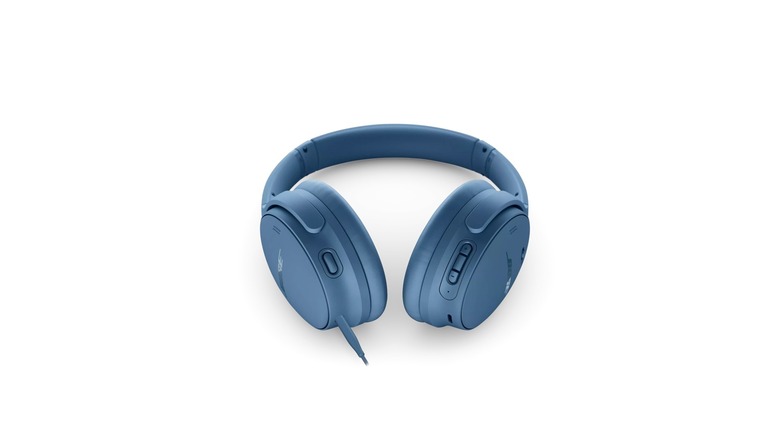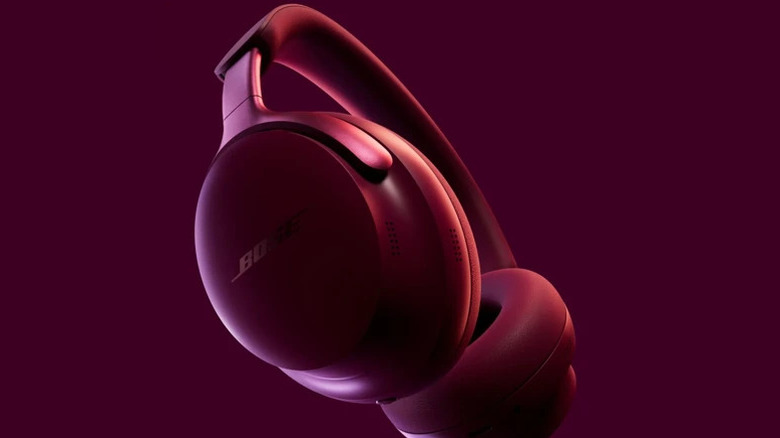Bose Vs. Beats In 2025: Which Sound Better, And Feel Nicer According To Owners?
When it comes to headphones, the two most famous brands that come to mind are surely Bose and Beats. Both are famous for their noise-canceling, allowing consumers to block out a rumbling bus, jet engine, or busy café. The question remains: Which brand offers the better product right now? Which headphones have supreme sound and noise-canceling performance? Which brand has the more comfortable pair of cans? And which offers better features when it comes to smartphone integration? Based on SlashGear reviews and other reputable sources, we'll answer those questions for you to help you pick the right pair.
While we've published a comprehensive ranking of every headphone brand on the market and a look at our top five Bluetooth headphones, today we are focusing on Bose and Beats alone. Whether you're a casual listener or an audiophile, you'll want to pick the best pair for you and your needs, at the best price. You might be using your headphones for making phone calls, listening to music while commuting, or even at the gym. Whatever your use, we'll go through design, sound, and comfort to help you make the best choice.
Both brands have two headphones on the market. Bose has its cheaper QuietComfort and their top-of-the-line QuietComfort Ultra. Likewise, Beats has the cheaper Solo 4 ($200) and the flagship Studio Pro. Beats clearly come in as the cheaper brand, but does Bose justify the extra expense? We'll dig into that below.
Bose vs. Beats: sound and noise-canceling
Let's dig into what we're ultimately here for: the sound. We'll compare Bose vs. Beats based on their sound profile (how balanced and clear the audio is), their noise-canceling ability, and their microphones. While Beats were once infamous for an over-emphasized, muddy bass sound, this is no longer the case. In our reviews of both the Beats Solo 4 and Beats Studio Pro, we found a well-balanced and even sound.
In fact, it's the Bose headphones, both the QuietComfort and the Ultra version, that have a louder bass, described as being warm without being muddy. Of these four models, the QuietComfort Ultra comes out on top, and the QuietComfort comes out least even in sound profile comparisons. Tests looking at sound profiles, though, are just one part of the picture. These Redditors welcomed the louder bass of the Bose headphones, and felt the sound was better overall. Ultimately, sound is subjective.
For noise-canceling, Bose, often praised for its ANC, comes out on top. Of course, the Beats Solo 4's noise-canceling falls behind, given it doesn't have active noise cancellation. When comparing both of Bose's headphones with the Beats Studio Pro, Bose is the winner. Its noise cancellation is simply considered to be better by reviewers such as RTINGS, and its app allows further fine-tune control. As for the microphones, the picture is less clear. Neither brand's microphones are universally referred to as "excellent." Using Bose headphones in a quiet environment, your voice will be clearer and natural. In a loud environment, such as a café or near a train, the QuietComfort may struggle to handle the noise. The QuietComfort Ultra is the best of the bunch, but your voice might be unclear in a loud environment, as this reviewer suggested.
Bose vs. Beats: build and comfort
Of course, we should also mention the build and comfort of these headphones. After all, we sometimes spend hours and hours wearing headphones at home, in the office, or at the gym, and there's nothing worse than having headphones that are too tight or hurt your head after 30 minutes of use. Us glasses-wearers also know the pain of having a tight pair of headphones that feels even worse when your glasses are on. In our reviews, we loved the fit and feel of both the Beats Solo 4 and Studio Pro. The Solo 4, though, has ear cups that sit on top of your ears, rather than wrapping around. This means they might be more prone to falling off if used when exercising. Nonetheless, these four headphones all seem pretty similar when it comes to stability.
For general comfort, Bose seems to be the winner. Reviewers and consumers both comment on the Beats Studio Pro being a bit uncomfortable after prolonged use; this might especially be the case if you have a larger head or ears. The ear cups are shallower compared to their Bose counterparts, and the headband could also use more cushioning. As such, they might cause soreness after extended use, but as always, this varies by user.
The build quality of all four headphones is similar, mostly made of plastic with a few metal parts. All are described as sturdy, lightweight, and durable. For the sake of comfort, though, Bose is the clear winner here. The QuietComfort and QuietComfort Ultra have certainly stayed true to their name.
Bose vs. Beats: design and features
Let's take a look at the design and features of these headphones. All four offer wireless listening via Bluetooth, as well as wired options. As far as battery goes, the Beats Studio Pro and Bose QuietComfort Ultra have the same capacity at 24 hours. For the cheaper Solo 4 and QuietComfort, the difference is stark. The Solo 4 has a whopping 50 hours of battery, compared to the QuietComfort's 24. However, the reason for this is important. The Solo 4 doesn't have active noise-cancellation, meaning it has no electronics to reduce noise and only relies on the cups covering your ears.
Importantly, Beats do offer the ability to use your headphones while charging via USB-C. On the other hand, Bluetooth doesn't work on Bose headphones while they are being charged. This means you can only listen to music while charging by using the lower-fidelity passive mode through an audio cable. As for controls, these headphones are pretty similar. All four have a power button, which you hold to activate Bluetooth pairing. Likewise, all have a multifunction button to play/pause, to answer and hang up calls, and for track skipping. RTINGS praised Bose's QuietComfort for having dedicated controls for adjusting volume; while you can control volume on the other headphones, you'll need to use a slider or a button without clear and audible feedback.
For app support, we have a clear winner in Bose. You can access EQ presets, and customize your own, something that you can't do with Beats' app. The Bose app also allows you to switch between different ANC profiles. Beats, on the other hand, simply lets you switch between on and off in the app. Of course, this doesn't apply to the Solo 4, which doesn't have ANC at all.
Which headphones are better?
Ultimately, it's hard to compare Bose to Beats, as both offer headphones of a slightly different caliber. But based on our own reviews, as well as the thoughts of reputable reviewers and people who used these headphones, Bose's QuietComfort Ultra is the clear winner, on sound, design and comfort. No surprise, though, given that it's the most expensive of the bunch, at $429. The Beats Solo 4 sits on the other end of the spectrum, at $200. Of course, it has no active noise-cancellation — a feature common in modern headphones.
Between the Beats Studio Pro ($350) and Bose's QuietComfort ($349), the QuietComfort comes out ahead. The sound and the noise cancellation is better. The headphones themselves are more comfortable and great to wear for a long stretch of time. And Bose's app support is often considered to be better, allowing you to access EQ presets and fine-tune the ANC.
Perhaps the only area in which Beats has Bose beat is Apple integration, since Apple has owned Beats since 2014. If you use a lot of Apple products and are deep in that ecosystem, Beats does come in handy. For instance, you don't need an additional app: Beats integrates automatically with Apple's Settings, and the Beats Studio Pro also allows you to use Apple's 'Find My Beats' if you lose your headphones.
Methodology
To write this article, we carried out our own extensive research and used information provided by Beats and Bose online. Besides using our own published reviews, we also consulted consumer reviews and online discussions, other professional reviews, and detailed comparative tests.
Our analysis looked at three key categories: design and features, sound and noise cancellation, and build and comfort. For design and features, we looked at their battery, onboard controls and app features. For sound and noise cancellation, we looked at things like sound profile and noise isolation. Of course, subjective user experiences were important, too.
Finally, for comfort, we looked at tests comparing stability and materials used. Again, we made sure to look at reviews discussing comfort. Finally, we factored in price, evaluating what each model offers relative to its cost.
